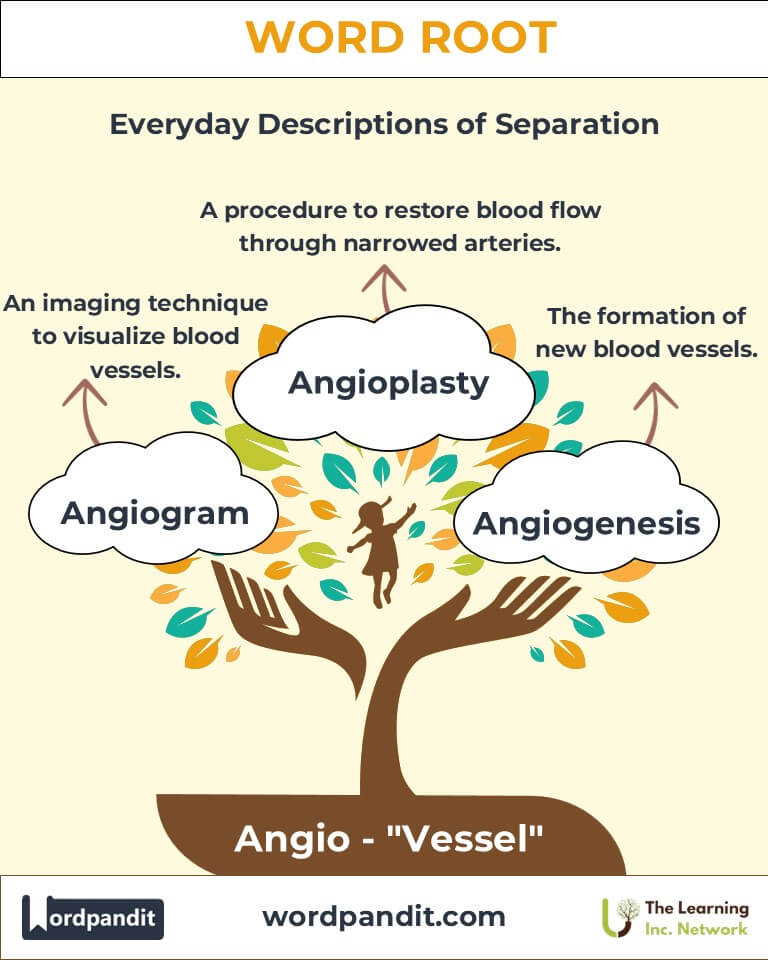Angio: The Pathway to Understanding Vessels in Science and Medicine
Delve into the fascinating world of the root "angio," derived from the Greek word angeion, meaning "vessel." From diagnostic tools like angiograms to critical conditions like angiosarcoma, this root forms the foundation of terminology that explores the intricate network of vessels in the human body and beyond.

Table of Contents
- Introduction: The Essence of Angio
- Etymology and Historical Journey
- Mnemonic: Unlocking the Power of Angio
- Common Angio-Related Terms
- Angio Through Time
- Angio in Specialized Fields
- Illustrative Story: Angio in Action
- Cultural Significance of the Angio Root
- The Angio Family Tree
- FAQs about the Angio Word Root
- Test Your Knowledge: Angio Word Root Quiz
- Conclusion: The Living Legacy of Angio
Introduction: The Essence of Angio
The root "angio," pronounced an-jee-oh, translates to "vessel" and predominantly refers to blood vessels or other tubular structures that transport essential fluids. Its relevance extends across fields like medicine, biology, and botany. In modern science, understanding this root is key to comprehending terms related to vascular systems, their functions, and their disorders.

Etymology and Historical Journey
The root "angio" originates from the Greek word angeion, meaning "vessel" or "container." In ancient times, it referred to any structure designed to hold or transport fluids. As medical knowledge advanced, the term became synonymous with blood vessels and lymphatic channels, forming the basis of vascular studies. It entered the English language through Latinized adaptations, retaining its core meaning in specialized scientific vocabularies.
Mnemonic: Unlocking the Power of Angio
To remember "angio," think of a garden hose, a vessel delivering water to plants, similar to how blood vessels carry nutrients through the body.
Mnemonic Device: "Angio flows like a garden hose, delivering life wherever it goes."
Common Angio-Related Terms
- Angiogram (an-jee-oh-gram)
- Definition: An imaging test that uses X-rays to view blood vessels.
- Example: "The angiogram revealed a blockage in the coronary artery."
- Angiosarcoma (an-jee-oh-sar-koh-muh)
- Definition: A rare and aggressive cancer of the blood or lymphatic vessels.
- Example: "The patient was diagnosed with angiosarcoma after persistent symptoms."
- Angiogenesis (an-jee-oh-jen-uh-sis)
- Definition: The formation of new blood vessels from pre-existing ones.
- Example: "Angiogenesis plays a crucial role in wound healing and cancer growth."
- Angioplasty (an-jee-oh-plas-tee)
- Definition: A procedure to restore blood flow through narrowed or blocked arteries.
- Example: "The doctor recommended an angioplasty to open the blocked artery."
- Hemangioendothelioma (hee-man-jee-oh-en-doh-thee-lee-oh-muh)
- Definition: A tumor of blood vessel endothelial cells.
- Example: "Hemangioendothelioma is typically diagnosed in infancy or childhood."
Angio Through Time
- Angiography (20th Century): With advancements in imaging technologies, angiography revolutionized vascular diagnosis, making it easier to detect blockages and anomalies.
- Angiogenesis (Modern Medicine): Initially studied for wound healing, its role in tumor growth spurred research in oncology, leading to targeted therapies.
Angio in Specialized Fields
- Medicine:
- Angioplasty: Widely used to treat coronary artery disease, this procedure has saved countless lives.
- Application: Restoring blood flow to the heart.
- Oncology:
- Angiosarcoma: Highlights the aggressive potential of vascular-based tumors.
- Relevance: Focus of targeted cancer therapies.
- Biology:
- Angiogenesis: Central to understanding tissue growth and repair.
- Application: Studied in regenerative medicine.
- Botany:
- Angiosperm: Flowering plants whose seeds develop inside protective vessels.
- Significance: Reflects the root’s broader biological relevance.
Illustrative Story: Angio in Action
Dr. Mira Patel was a pioneer in vascular imaging. One day, a middle-aged patient complained of chest pain. Using an angiogram, Dr. Patel identified a critical blockage in the coronary artery. She performed an angioplasty, restoring blood flow and saving the patient’s life. Later, she explained how angiogenesis could also contribute to post-surgical recovery. Her work exemplified the life-saving importance of "angio"-based diagnostics and interventions.
Cultural Significance of the Angio Root
The root "angio" symbolizes life’s flow—blood, lymph, and even the nurturing vessels of plants. Its influence extends to metaphors, like the "lifeblood" of organizations, reflecting the vital pathways that sustain health, growth, and function.

The Angio Family Tree
- Hem-/Hemo- (blood)
- Hemoglobin: The protein in red blood cells that carries oxygen.
- Hemophilia: A disorder affecting blood clotting.
- Vas-/Vaso- (vessel)
- Vasodilation: The widening of blood vessels.
- Vasectomy: Surgical removal or blockage of the vas deferens.
- Arter-/Arterio- (artery)
- Arteriosclerosis: Hardening of the arteries.
- Arteriogram: An imaging study of arteries.
FAQs About " Angio "
Q: What does the root "angio" mean, and why is it important in science?
A: The root "angio" comes from the Greek word angeion, meaning "vessel" or "container." It is widely used in scientific terminology to describe tubular structures, especially blood and lymphatic vessels in medicine, as well as seed-enclosing structures in plants. This root is fundamental in understanding vascular health, diagnostic tools, and botanical classifications.
Q: What is the function of an angiogram?
A: An angiogram is an imaging technique that uses X-rays and contrast dye to visualize blood vessels. It helps detect blockages, narrowing, or abnormalities in arteries and veins. For instance, it’s often used to diagnose coronary artery disease or assess the extent of vascular damage after a heart attack.
Q: How does angiogenesis impact health?
A: Angiogenesis, the process of forming new blood vessels, is vital for healing wounds and regenerating tissues. However, in diseases like cancer, abnormal angiogenesis enables tumors to create their own blood supply, promoting growth. This dual role makes angiogenesis a key area of research in medicine.
Q: What is angiosarcoma, and how does it differ from other cancers?
A: Angiosarcoma is a rare and aggressive cancer that arises from the endothelial cells lining blood or lymphatic vessels. Unlike many other cancers, it often grows quickly and has a high potential to spread to other parts of the body, making early detection and treatment crucial.
Q: What role does "angio" play in botany?
A: In botany, the term "angio" is used in angiosperm, which refers to flowering plants that produce seeds enclosed within a protective vessel, such as a fruit. This distinguishes them from gymnosperms, which have exposed seeds.
Q: What is the purpose of angioplasty, and how is it performed?
A: Angioplasty is a medical procedure used to restore blood flow in narrowed or blocked arteries. A thin catheter with a balloon at the tip is inserted into the affected artery. The balloon is inflated to widen the artery, often followed by the placement of a stent to keep it open and improve circulation.
Q: How do abnormalities in angiogenesis affect diseases?
A: Abnormal angiogenesis can either be excessive, leading to tumor growth or eye diseases like diabetic retinopathy, or insufficient, causing issues like chronic wounds or ischemic heart disease. Regulating angiogenesis is a major focus in developing treatments for these conditions.
Test Your Knowledge: " Angio " Mastery Quiz
1. What does the root "angio" mean?
2. What is angiogenesis?
3. What is the primary purpose of an angiogram?
4. Which of the following describes angiosarcoma?
5. What does angioplasty aim to accomplish?
Conclusion: The Living Legacy of Angio
The root "angio" serves as a vital key to understanding the pathways that sustain life. From medicine to botany, its applications reveal the interconnectedness of biological systems. As science progresses, "angio" continues to illuminate the intricate networks within and around us, emphasizing the importance of these vessels in the fabric of life.












